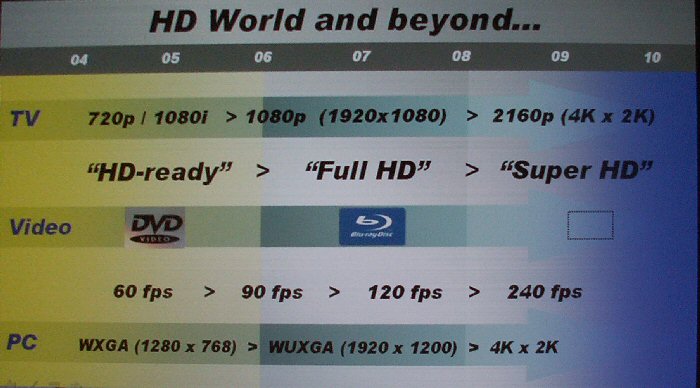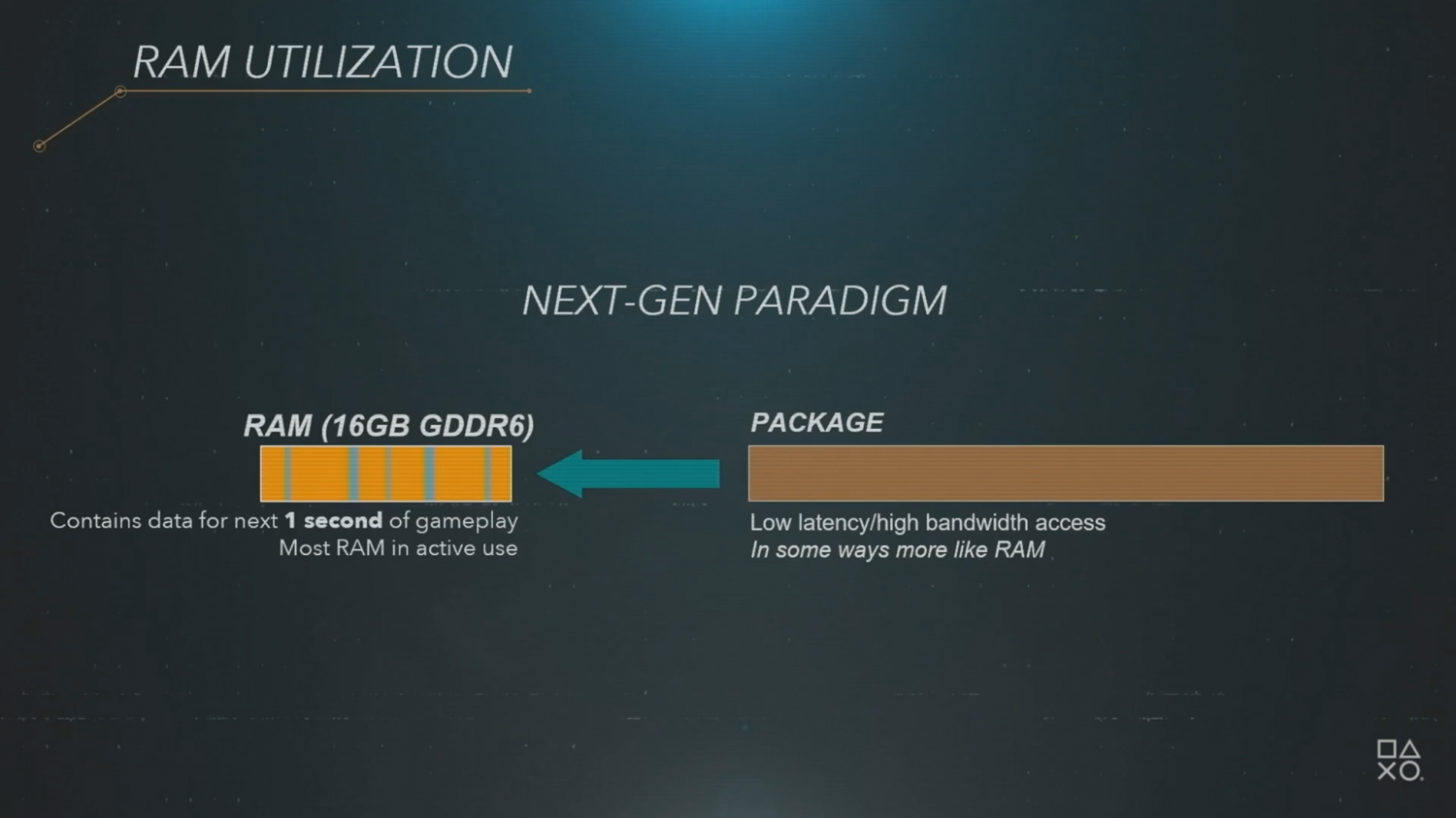Gamernyc78
Banned
Sony isn't talking about XSX at all. MS has no class.
Thy don't need too Sony walks tht walk and ends up being leagues better where it really counts. No minute man here but here for the long hall
Sony isn't talking about XSX at all. MS has no class.
This never happened, it was a mistranslation by Gamespot which got propagated by other games media. He was talking about video and movies with the development of newer interface standards and how the cell processor is capable of keeping up with the newer standards. Its the same thing that happened with people claiming Sony said PS2 could produce toy story graphics, they never said that.Nothing, I never said anything about PS5. Someone said that Spencer lies, and I said that if Spencer says XSX will have games that support 120fps that will be at least true in his case. It was a joke referring back to the PS3 Era when Sony was boasting about the power of the PS3 and that games would be able to run at 120fps.


Microsoft: We Could Have Used Variable Clocks for Xbox Series X, But We're Not Interested in TFLOPS Numbers
Microsoft's Jason Ronald said that the Xbox Series X could have used variable clocks like the PS5, but the company isn't looking to boast higher TFLOPS.www.wccftech.com



You are joking, right? Sony is always talking about Xbox next-gen if they do something differently...Sony isn't talking about XSX at all. MS has no class.
MODS, help me.
I am meant to be a protected species in here.
Where's Geordie, as a fellow member of the United Kingdom he will back me up.
Oh wait hes Scottish, never mind.
As for going out, Say hello to your Therapist, ask for more pills.
And i don't mind being insulted by covid, neogaf personal but did you have to scoop so low with the xbox guy kicking me. Unforgettable.
Peace to my Xbox friends out there.
Join forces with me, ATTACK BO.

You are joking, right? Sony is always talking about Xbox next-gen if they do something differently...
Matt Booty says we will keep supporting Xbox One for 1-2 years, Sony immediately responded by saying don't worry we do have things that you can only play on PS5. This is exactly the same... Sony says we have variable clocks, Microsoft says don't worry we don't have variable clocks because we believe that's shit.
And that's OK btw, they both do this, and that's normal.
MODS, help me.
I am meant to be a protected species in here.
Where's Geordie, as a fellow member of the United Kingdom he will back me up.
Oh wait hes Scottish, never mind.
As for going out, Say hello to your Therapist, ask for more pills.
And i don't mind being insulted by covid, neogaf personal but did you have to scoop so low with the xbox guy kicking me. Unforgettable.
Peace to my Xbox friends out there.
Join forces with me, ATTACK BO.
Are we really talking about what a MS engineer said about PS5 over what Cerny, console lead architect, already said?
You are joking, right? Sony is always talking about Xbox next-gen if they do something differently...
Matt Booty says we will keep supporting Xbox One for 1-2 years, Sony immediately responded by saying don't worry we do have things that you can only play on PS5. This is exactly the same... Sony says we have variable clocks, Microsoft says don't worry we don't have variable clocks because we believe that's shit.
And that's OK btw, they both do this, and that's normal.
Microsoft said the 1-2 years comments I think a year ago... PS5 PR said the generation comment this year because of questions on the media regarding the MS comments...
It's Microsoft the one posting the day after a Sony event, saying that some games will be playable on Xbox, it's MS commenting on the "no boost mode" referring to Sony...
Let me see, do I believe a MS engineer with no contact whatsoever with PS5 R&D or PS5 lead architect? Hmm, tough one...both are engineers, both worked on next gen platforms, and the most important, part of their job is to sell the “Amazingness“ of their creations, I am saying that we should take all of these statements with the pinch of salt (at least until we see some proper gameplay comparisons).
Just one game? Ok I'll take that into account with games on the ps5 as well. As long as there's one game at 120FPS then that's possible on the system.
Actually 3 games so far:
2nd one:
3rd
He really delivered, I guess.
Actually 3 games so far:
2nd one:
3rd
He really delivered, I guess.
PlayStation 5's boost clocks and how they work
PlayStation 5 uncovered: the Mark Cerny tech deep dive
On March 18th, Sony finally broke cover with in-depth information on the technical make-up of PlayStation 5. Expanding …www.eurogamer.net
One of the areas I was particularly interested to talk about was the boost clock of the PlayStation 5 - an innovation that essentially gives the system on chip a set power budget based on the thermal dissipation of the cooling assembly. Interestingly, in his presentation, Mark Cerny acknowledged the difficulties of cooling PlayStation 4 and suggested that having a maximum power budget actually made the job easier. "Because there are no more unknowns, there's no need to guess what power consumption the worst case game might have," Cerny said in his talk. "As for the details of the cooling solution, we're saving them for our teardown, I think you'll be quite happy with what the engineering team came up with."
Regardless, the fact is that there is a set power level for the SoC. Whether we're talking about mobile phones, tablets, or even PC CPUs and GPUs, boost clocks have historically led to variable performance from one example to the next - something that just can't happen on a console. Your PS5 can't run slower or faster than your neighbour's. The developmental challenges alone would be onerous to say the least.
"We don't use the actual temperature of the die, as that would cause two types of variance between PS5s," explains Mark Cerny. "One is variance caused by differences in ambient temperature; the console could be in a hotter or cooler location in the room. The other is variance caused by the individual custom chip in the console, some chips run hotter and some chips run cooler. So instead of using the temperature of the die, we use an algorithm in which the frequency depends on CPU and GPU activity information. That keeps behaviour between PS5s consistent."
Inside the processor is a power control unit, constantly measuring the activity of the CPU, the GPU and the memory interface, assessing the nature of the tasks they are undertaking. Rather than judging power draw based on the nature of your specific PS5 processor, a more general 'model SoC' is used instead. Think of it as a simulation of how the processor is likely to behave, and that same simulation is used at the heart of the power monitor within every PlayStation 5, ensuring consistency in every unit.
"The behaviour of all PS5s is the same," says Cerny. "If you play the same game and go to the same location in the game, it doesn't matter which custom chip you have and what its transistors are like. It doesn't matter if you put it in your stereo cabinet or your refrigerator, your PS5 will get the same frequencies for CPU and GPU as any other PS5."
Feedback from developers saw two areas where developers had issues - the concept that not all PS5s will run in the same way, something that the Model SoC concept addresses. The second area was the nature of the boost. Would frequencies hit a peak for a set amount of time before throttling back? This is how smartphone boost tends to operate.
"The time constant, which is to say the amount of time that the CPU and GPU take to achieve a frequency that matches their activity, is critical to developers," adds Cerny. "It's quite short, if the game is doing power-intensive processing for a few frames, then it gets throttled. There isn't a lag where extra performance is available for several seconds or several minutes and then the system gets throttled; that isn't the world that developers want to live in - we make sure that the PS5 is very responsive to power consumed. In addition to that the developers have feedback on exactly how much power is being used by the CPU and GPU."
Mark Cerny sees a time where developers will begin to optimise their game engines in a different way - to achieve optimal performance for the given power level. "Power plays a role when optimising. If you optimise and keep the power the same you see all of the benefit of the optimisation. If you optimise and increase the power then you're giving a bit of the performance back. What's most interesting here is optimisation for power consumption, if you can modify your code so that it has the same absolute performance but reduced power then that is a win. "
In short, the idea is that developers may learn to optimise in a different way, by achieving identical results from the GPU but doing it faster via increased clocks delivered by optimising for power consumption. "The CPU and GPU each have a power budget, of course the GPU power budget is the larger of the two," adds Cerny. "If the CPU doesn't use its power budget - for example, if it is capped at 3.5GHz - then the unused portion of the budget goes to the GPU. That's what AMD calls SmartShift. There's enough power that both CPU and GPU can potentially run at their limits of 3.5GHz and 2.23GHz, it isn't the case that the developer has to choose to run one of them slower."
"There's another phenomenon here, which is called 'race to idle'. Let's imagine we are running at 30Hz, and we're using 28 milliseconds out of our 33 millisecond budget, so the GPU is idle for five milliseconds. The power control logic will detect that low power is being consumed - after all, the GPU is not doing much for that five milliseconds - and conclude that the frequency should be increased. But that's a pointless bump in frequency," explains Mark Cerny.
PS5 caps its CPU and GPU clocks at 3.5GHz and 2.23GHz respectively, but how stable are the frequencies?
At this point, the clocks may be faster, but the GPU has no work to do. Any frequency bump is totally pointless. "The net result is that the GPU doesn't do any more work, instead it processes its assigned work more quickly and then is idle for longer, just waiting for v-sync or the like. We use 'race to idle' to describe this pointless increase in a GPU's frequency," explains Cerny. "If you construct a variable frequency system, what you're going to see based on this phenomenon (and there's an equivalent on the CPU side) is that the frequencies are usually just pegged at the maximum! That's not meaningful, though; in order to make a meaningful statement about the GPU frequency, we need to find a location in the game where the GPU is fully utilised for 33.3 milliseconds out of a 33.3 millisecond frame.
"So, when I made the statement that the GPU will spend most of its time at or near its top frequency, that is with 'race to idle' taken out of the equation - we were looking at PlayStation 5 games in situations where the whole frame was being used productively. The same is true for the CPU, based on examination of situations where it has high utilisation throughout the frame, we have concluded that the CPU will spend most of its time at its peak frequency."
Put simply, with race to idle out of the equation and both CPU and GPU fully used, the boost clock system should still see both components running near to or at peak frequency most of the time. Cerny also stresses that power consumption and clock speeds don't have a linear relationship. Dropping frequency by 10 per cent reduces power consumption by around 27 per cent. "In general, a 10 per cent power reduction is just a few per cent reduction in frequency," Cerny emphasises.
It's an innovative approach, and while the engineering effort that went into it is likely significant, Mark Cerny sums it up succinctly: "One of our breakthroughs was finding a set of frequencies where the hotspot - meaning the thermal density of the CPU and the GPU - is the same. And that's what we've done. They're equivalently easy to cool or difficult to cool - whatever you want to call it."
There's likely more to discover about how boost will influence game design. Several developers speaking to Digital Foundry have stated that their current PS5 work sees them throttling back the CPU in order to ensure a sustained 2.23GHz clock on the graphics core. It makes perfect sense as most game engines right now are architected with the low performance Jaguar in mind
- even a doubling of throughput (ie 60fps vs 30fps) would hardly tax PS5's Zen 2 cores. However, this doesn't sound like a boost solution, but rather performance profiles similar to what we've seen on Nintendo Switch. "Regarding locked profiles, we support those on our dev kits, it can be helpful not to have variable clocks when optimising. Released PS5 games always get boosted frequencies so that they can take advantage of the additional power," explains Cerny.
But what if developers aren't going to optimise specifically to PlayStation 5's power ceiling? I wondered whether there were 'worst case scenario' frequencies that developers could work around - an equivalent to the base clocks PC components have. "Developers don't need to optimise in any way; if necessary, the frequency will adjust to whatever actions the CPU and GPU are performing," Mark Cerny counters. "I think you're asking what happens if there is a piece of code intentionally written so that every transistor (or the maximum number of transistors possible) in the CPU and GPU flip on every cycle. That's a pretty abstract question, games aren't anywhere near that amount of power consumption. In fact, if such a piece of code were to run on existing consoles, the power consumption would be well out of the intended operating range and it's even possible that the console would go into thermal shutdown. PS5 would handle such an unrealistic piece of code more gracefully."
Right now, it's still difficult to get a grip on boost and the extent to which clocks may vary. There has also been some confusion about backwards compatibility, where Cerny's comments about running the top 100 PlayStation 4 games on PS5 with enhanced performance were misconstrued to mean that only a relatively small amount of titles would run at launch. This was clarified a couple of days later (expect thousands of games to run) but the nature of backwards compatibility on PlayStation 5 is fascinating.
PlayStation 4 Pro was built to deliver higher performance than its base counterpart in order to open the door to 4K display support, but compatibility was key. A 'butterfly' GPU configuration was deployed which essentially doubled up on the graphics core, but clock speeds aside, the CPU had to remain the same - the Zen core was not an option. For PS5, extra logic is added to the RDNA 2 GPU to ensure compatibility with PS4 and PS4 Pro, but how about the CPU side of the equation?
"All of the game logic created for Jaguar CPUs works properly on Zen 2 CPUs, but the timing of execution of instructions can be substantially different," Mark Cerny tells us. "We worked to AMD to customise our particular Zen 2 cores; they have modes in which they can more closely approximate Jaguar timing. We're keeping that in our back pocket, so to speak, as we proceed with the backwards compatibility work."
They have a specific TDP in mind with that APU. The more CUs, the more heat is generated. Probably they already figured out their ideal frequency and will stick with it to make their architecture the best it can be.Wonder if Microsoft will upclock the gpu, closer to PS5 specs.
Wonder if Microsoft will upclock the gpu, closer to PS5 specs.
Just a reminder that this is one of the best posts in neoGAF history. Lol
Just a reminder that this is one of the best posts in neoGAF history. Lol
Well I'm not sure where I'm going wrong, because I went back to the GDC video and he says "effectively constant power" and describes them providing more than enough power, then ramping up clocks on the CPU and GPU to the limit of the cooling solution - presummably using typical workloads, rather than maximums- and then taking that power draw as the maximum, meaning workload that would exceed that power draw gets downclocked to maintain constant power draw, and obviously stay within the limits of the quiet cooling solution.
how come we believe everything coming from Sony and treating any statements from MS as bs?
Remember VR games are 90/120 FPS even on current gen
Those things can be true.
But the likelihood is, be it through 1:1 feature parity or through analogous technologies, the PS5 also has those capabilities. And it has double the raw speed.
This really should not be up for debate.
Just imagine the use of ray-tracing we’re gonna see towards the end of the PS5’s lifecycle.
I had some thoughts about console pricing today. Lets assume the following start prices for both consoles:
PS5 Disc: 500$
PS5 Digital: 400$
XSX: 400$
XSS: 250$
In this scenario Sony might have trouble keeping their installbase advantage over MS in the beginning of this generation. So for Sony to offer a cheaper entry into their new gen and their ecosystem overall they could make the Digital Version even cheaper 1 or 2 years into the gen, while keeping the disc version at 500$.
People would have more incentive purchasing the digital edition, which in turn would guarantee Sony to make more money with their PSN and PS-Store on per customer basis.
However dropping the price of the Digital Edition even further would mean they would potentially make less profit with the hardware then the gen before. This would need to be compensated.
And I think this could actually be Sonys greatest incentive to reduce game development time to 3 years tops for each title while shortening the estimated gameplay time.
They could be aimimg at 25ish hour titles as a base for 60-80$ and/or Sequels/Prequels/Spinnofs/DLCs with 10-15is hours for 30-50$ .
The more games a first party development team of sony creates in a console lifespan the more Sony would earn in return. Especially if they manage to "lure" more customers into their digital portfolio.
Anyone else here who could see that happening?
Not a big fan either. They're ready to defend themselves from birth born with sharp teeth and claws, deceptive miniature killing machines trying to earn your affection with their cute fluffiness, not so sweet innocent and defenseless they make themselves out to be are they! It's only a matter of time they start evolving for their uprising...I kinda scoffed at the idea of this cat game when i first saw it but i must say that is looking very good indeed.
Ps I still don't like cats and there's to many of them on this forum. DIE DIE DIE
Sony is a pretty tough challengerMaybe because they have a history of spreading bullshit?
Yep you got the idea!
I can see them not caring about profit on the digital edition. For me even if the Digital edition costs 200 dollars less i wouldn't buy that. But the people who will buy the digital one, will be more profitable for them in the long run. That console is basically what MS tried with their console at the start in the last generation. You can't buy used games, you can not simply share like you do with a physical copy of a game. I have no clue how sharing works on PS4, but as far as i know you can only share a game to one person right?I had some thoughts about console pricing today. Lets assume the following start prices for both consoles:
PS5 Disc: 500$
PS5 Digital: 400$
XSX: 400$
XSS: 250$
In this scenario Sony might have trouble keeping their installbase advantage over MS in the beginning of this generation. So for Sony to offer a cheaper entry into their new gen and their ecosystem overall they could make the Digital Version even cheaper 1 or 2 years into the gen, while keeping the disc version at 500$.
People would have more incentive purchasing the digital edition, which in turn would guarantee Sony to make more money with their PSN and PS-Store on per customer basis.
However dropping the price of the Digital Edition even further would mean they would potentially make less profit with the hardware then the gen before. This would need to be compensated.
And I think this could actually be Sonys greatest incentive to reduce game development time to 3 years tops for each title while shortening the estimated gameplay time.
They could be aimimg at 25ish hour titles as a base for 60-80$ and/or Sequels/Prequels/Spinnofs/DLCs with 10-15is hours for 30-50$ .
The more games a first party development team of sony creates in a console lifespan the more Sony would earn in return. Especially if they manage to "lure" more customers into their digital portfolio.
Anyone else here who could see that happening?
"All of the game logic created for Jaguar CPUs works properly on Zen 2 CPUs, but the timing of execution of instructions can be substantially different," Mark Cerny tells us. "We worked to AMD to customise our particular Zen 2 cores; they have modes in which they can more closely approximate Jaguar timing. We're keeping that in our back pocket, so to speak, as we proceed with the backwards compatibility work."
Typical Rich. He was XBone's biggest fanboy. And still is apparently.
Yeah, that cell talk was pretty annoying. Agreed.Maybe because they have a history of spreading bullshit?
Only one smiley face and squirt after your Sony hypeman speech?!?!11!11?!!!Thy don't need too Sony walks tht walk and ends up being leagues better where it really counts. No minute man here but here for the long hall
Is it me or this gen is clearly the best ever for special editions ?
Well, if it's just resolution and framerate, there's always that MP game coming later...After seeing how good TLoU2 looks on a standard PS4 (with a rock solid frame rate, too) I can’t wait to see what Naughty Dog bring to PS5 deep into next generation.
Do we know if TLoU2 has any PS5 version yet? And whether it’s more than just a resolution and frame rate buff?

Thanks for reminding us of these part of the DF article. Always helpful to go over what the architect himself says about things. The above part right at the end I missed and I wonder what he means with the bold? And why the need to keep it in the back pocket...?
I admit the whole BC thing with Sony has been a ballache to me to be honest but this is actual proof there are hardware modes in the PS5 CPU for BC.
I really don't get why Sony have continued to obfuscate about it.
Just going back to comparisons between consoles another thing to consider and not always mentioned enough is useable ram. If this is right then this could be a big advantage for PS5..
Not sure if this is right but people have mentioned about ps5 OS is likely be less of the ram used maybe it should be able to just load almost instantly using the ssd and io speed, presuming that's what they do. If that's the case is almost full ram available compared to xbox 13.5GB?
Anyway... even if not then this slide is surely very important.

PS5 holds only data in ram for next second of gameplay leaving more for actual use. It's ssd is 2x faster and with io is at least 2x faster than the xbox. Because of eliminated bottlenecks and the xbox not having the dedicated hardware to eliminate them, the xbox is likely far more than 2x slower in actual use in games as cerny showed if you don't eliminate all bottlenecks in that slide.
This appears to be backed up by various different leaks and insiders we have had posted on here. Bg's said around 5x faster worst case for data management. A confirmed insider post from inside metal said similar although open to interpretation. Xbox uses cpu for io so likely to introduce latency.
Even just going off ssd speeds, at twice as slow the xbox would have to hold another second of gameplay in ram, if these higher amounts slower are true then surely this is going to be a bad result for the xbox with even more needing to be held in ram...
Thoughts?
I had some thoughts about console pricing today. Lets assume the following start prices for both consoles:
PS5 Disc: 500$
PS5 Digital: 400$
XSX: 400$
XSS: 250$
In this scenario Sony might have trouble keeping their installbase advantage over MS in the beginning of this generation. So for Sony to offer a cheaper entry into their new gen and their ecosystem overall they could make the Digital Version even cheaper 1 or 2 years into the gen, while keeping the disc version at 500$.
People would have more incentive purchasing the digital edition, which in turn would guarantee Sony to make more money with their PSN and PS-Store on per customer basis.
However dropping the price of the Digital Edition even further would mean they would potentially make less profit with the hardware then the gen before. This would need to be compensated.
And I think this could actually be Sonys greatest incentive to reduce game development time to 3 years tops for each title while shortening the estimated gameplay time.
They could be aimimg at 25ish hour titles as a base for 60-80$ and/or Sequels/Prequels/Spinnofs/DLCs with 10-15is hours for 30-50$ .
The more games a first party development team of sony creates in a console lifespan the more Sony would earn in return. Especially if they manage to "lure" more customers into their digital portfolio.
Anyone else here who could see that happening?
If PS5 DE is below $399 that thing is going to fly off the shelves. I don't know if Sony is willing to go that aggressive in price but I mean, wasn't there a report that last year's sales were almost split 50/50 between psysical and digital games? so it seems there is already a good chunk of people that mostly or only buys digital games and PS5 DE could be perfect for them.I hope Microsoft and Sony play a self-destructive and violent game of chicken over XSS and PS5DE pricing resulting in the latter being disgustingly underpriced.
I bought three game discs for the entire PS4 generation. The Persistence, which I now own digitally. GTA V, which I also now own digitally. And The Last of Us: Remastered, which I already owned digitally but bought in a different region so my wife could have subtitles in her own language as she liked to watch me play it.
If XSS could shave another £50 off what Sony wanted to sell PS5DE for I’d be very happy. Competition is great for all of us.
